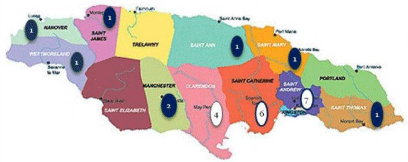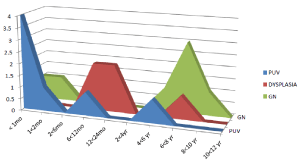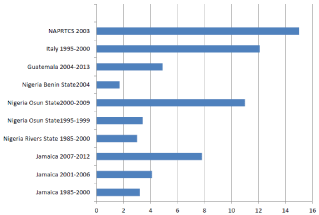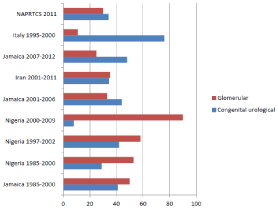
Research Article
Chronic Dis Int. 2016; 3(1): 1024.
Chronic Renal Failure in Jamaican Children : 2007-2012
Miller MEY¹* and Williams JA²
¹Department of Child and Adolescent Health, University of the West Indies, Jamaica
²The Bustamante Hospital for Children, Jamaica
*Corresponding author: Miller MEY, Department of Child and Adolescent Health, University of the West Indies, Mona, Kingston 7, Jamaica
Received: August 29, 2016; Accepted: October 16, 2016; Published: October 18, 2016
Abstract
This retrospective review documents the incidence, epidemiology, etiology and outcome of chronic renal failure in Jamaican children under age 12 years between 2007-2012.The required data were obtained from the medical records of Jamaica’s only two pediatric nephrology centres and by telephone review from pediatricians in rural hospitals. Twenty seven children (63% male) developed chronic renal failure between 2007-2012. The cumulative annual incidence per million child population < age 12 years was 7.83 and per million population 1.67. The average age at diagnosis of renal disease was 4.1 years (range birth - 10.5 years). The mean age at diagnosis of chronic renal failure was 4.39 years (range birth - 10.2 years). No child presented for the first time in end stage renal disease. Congenital urological disease (posterior urethral valves and renal dysplasia) was the commonest cause of chronic renal failure (48%), followed by glomerulonephritis (35%) only 2 cases of which were post infections (HIV and Dengue). Of 11 children progressing to end stage renal failure during this period, all 9 who were eligible received dialysis. Two children with severe comorbidities were excluded and died (end stage renal disease mortality of 7.4%). The incidence of chronic renal failure in Jamaican children continues to rise. Early diagnosis is usual. Posterior urethral valves contribute significantly to chronic renal failure. Chronic dialysis is now available to all eligible children. Our goal should now be renal transplantation.
Keywords: Chronic renal failure; Jamaican children; Glomerulonephritis; Posterior urethral valves; Dialysis
Abbreviations
CRF: Chronic Renal Failure; UTI: Urinary Tract Infections; CKD: Chronic Kidney Disease; PMARP: Per Million Age Related Population; PUV: Posterior Urethral Valves; VUR: Vesico-Ureteric Reflux; HIV: Human Immunodeficiency Virus; ESRD: End Stage Renal Disease; GFR: Glomerular Filtration Rate
Introduction
Jamaica is an island in the Western Caribbean with an estimated population in 2012 of 2.71 million of whom 19% are children under that age of 12 years [1]. Paediatric nephrology was introduced as a subspecialty in December 1984 and since then regular reviews of the incidence of CRF in children < age 12 years have been done. From 1985 to 2006 CRF data have shown both a shift in the aetiology of disease from acquired to congenital lesions as well as an increase in incidence [2,3]. In the 16 year period between 1985-2000 the cumulative annual incidence of CRF in Jamaican children was 3.2/ million child population < age 12 years compared with 4.1 in the 6 year period 2001- 2006 [2,3]. The incidence of CRF in Nigeria between 1985 -2000 was similar to ours at that time, with the same aetiological distribution [4]. However over the two periods of study, there has been, in Jamaica, a reduction in glomerular disease from 50% to 33.3% with congenital urological pathology predominating in the later review at 44.5% [3]. This is the pattern in developed countries such as North America [5]. On the other hand, glomerular disease still predominates in the current Nigerian literature [6,7].
Antenatal ultrasounds and prompt radiological investigation of first paediatric UTI are now more commonplace in Jamaica since the introduction of local protocols so earlier diagnosis of congenital urological abnormalities is possible.
In the developing world, dialysis for children is not universally available. Accessibility is limited by affordability [4,8]. Over last few years, more children in Jamaica have benefited from dialysis [3]. As more paediatricians become posted to additional rural parishes it is expected that there will be earlier recognition and diagnosis of CKD locally.
With better management, more children with CKD survive for longer periods and the illness poses a financial burden both to the individual as well as the country. There is a need for medication, dialysis and eventually transplantation. It is therefore crucial that there be current statistics to enable strategic intervention to prevent additional cases if preventable causes are identified. Additionally knowledge of the extent of the problem allows successive governments to predict and budget for the additional expenses and services that will be required to cope with the disease. The present retrospective study aims to address these issues by documenting all new cases of CRF in Jamaican children < age 12 years between 2007-12, providing current data about the incidence and causes of paediatric chronic renal failure locally and dialysis availability.
Patients and Methods
Jamaica is divided into 14 administrative regions (parishes). The business hub is in the parishes of Kingston and St. Andrew and it is here that the island’s two paediatric nephrology centres are located. All children islandwide with CRF are referred to paediatric renal centres at either the Bustamante Hospital for Children and the University Hospital of the West Indies.
Data on all Jamaican children under the age of 12 years diagnosed for the first time with CRF between 2007 - 2012 were identified by medical records search at the University Hospital of the West Indies and the Bustamante Hospital for Children and by telephone interview to paediatricians across the island to discover any children who had not yet been referred.
The cause and age at diagnosis of CRF, interval between diagnosis of renal disease and onset of CRF, sex, parish of origin, as well as access to renal replacement therapy and outcome (death or survival) were documented. Chronic renal failure was defined as CKD stage >3 (GFR <60ml/min/1.73m2) for least 3 months [9] or for <3 months if at diagnosis there were features of chronicity (anemia, bone disease) at presentation or SEVERE irreversible urological malformations [2]. GFR was calculated using the Schwartz formula [10]. As K/ DOQI guidelines for CKD staging do not apply to children < age 2 years, CRF in this age group was defined as estimated GFR < 25% of normal for age.
The annualized incidence PMARP < age 12 and per total population were calculated using the end year population statistics while the cumulative annual incidence PMARP < age 12 years and per million population were derived from the end of year population estimates for the mid study year (2009). Population statistics were based on the 2011 census [1].
Ethical approval was obtained from the SERAH (South East Regional Health Authority) and University of the West Indies/ University Hospital of the West Indies Ethics Committee.
Results
Between 2007 and 2012 twenty seven new children were diagnosed with chronic renal failure. There were 17 males with a male:female ratio of 1.7:1. The cumulative annual incidence PMARP < age 12 years was 7.83, and the cumulative annual incidence/million population 1.67. The mean annualized incidence PMARP was 8.3 and per million population 1.66. Most (68%) of the 25 children in whom the parish of origin was known, came from parishes on the south coast in or near Kingston and St. Andrew (Figure 1). There were no cases of CRF from St. Elizabeth, Trelawny and Portland.

Figure 1: Distribution of cases of chronic renal failure in children under age 12 years(2007-2012) (25 of 27 children).
Age at diagnosis and aetiology
The commonest cause of CRF was urological disease (48%) distributed equally between PUV and renal dysplasia. There was no other cause of obstructive uropathy. Glomerulonephritis accounted for only 25% of cases with two cases being post infectious (Dengue and HIV) and two being congenital nephrotic syndrome. The mean age at diagnosis of CRF was 4.39 years (range birth to 10.2 years) and all children with urological disease presented with CRF at age < 6years compared to those with glomerulonephritis and miscellaneous conditions. Dengue resulted in CRF in 2 children - one with ATN and the other with nephrotic syndrome (Table 1) (Figures 2,3).
Aetiology of chronic renal failure
%
Number of patients
Age at diagnosis of CKD
(years)
<6
6-11
UROLOGICAL (13)
PUV (± VUR ± dysplasia)
Dysplasia
Dysplasia and primary VUR
48
13
7
5
1
0
0
0
0
GLOMERULONEPHRITIS (7)
Post infectious (HIV, Dengue)
Systemic lupus erythematosus
Focal segmental glomerulosclerosis
Congenital nephrotic syndrome
25
3
1
0
0
2
4
1
1
2
0
HEREDITARY renal disease
Bardet Beidl syndrome
Autosomal recessive polycystic kidney disease
8
1
0
1
1
1
0
MISCELLANEOUS
Ischaemic
Trauma
Wilms tumour
Unknown
19
2
1
0
1
0
3
1
1
0
1
TOTAL
19
8
Table 1: Aetiology of chronic renal failure in Jamaican children (2007-2012).

Figure 2: Age at diagnosis of renal disease causing chronic renal failure.
PUV: Posterior Urethral Valves; GN: Glomerulonephritis.

Figure 3: Age at onset of chronic renal failure in children in children with
urological and glomerular disease. PUV (Posterior urethral valves); GN
(Glomerular diseases).
The mean age at diagnosis of renal disease was 4.1 years (range - from birth to 9.2 years). The mean interval from the diagnosis of renal disease to CRF was 4.39 years (range 0 - 10.2 years). The mean age at diagnosis of urological disease was less (1.4 years: range from birth -7.8 years) compared with than that of glomerular disease (4.46 years: range 2 months - 6 years). No child had ESRD at first presentation with renal disease. Most children with PUV and renal dysplasia had CRF at the time of diagnosis which was in the first 2 months of life (PUV) or between 6-24months (dysplasia).
Outcome
At the time of data collection dialysis had been started on all eligible children needing renal replacement(10/12 or 83.3%) The 2 excluded patients had significant associated co- morbidities (metastatic Wilms tumour, and severe cerebral palsy. Both died. The all cause mortality rate was 33.3% (10/27) while the ESRD related mortality was 7.4% (2/27). Other causes of death included pneumonia [1], interdialytic fluid overload, sepsis [2], complications of systemic lupus erythematosus and Dengue fever-related cardiopulmonary disease.
Discussion
In Jamaica the incidence of CRF in children age < 12 years increases with each successive review. The cumulative annual incidence in this six year cohort has more than doubled from the initial study: from an incidence of 3.2 PMARP between 1985-2000 [2] to 7.83 PMARP in the present study (2007-2012). This may in part be due to better diagnosis of CRF across the island as more hospitals in rural parishes are staffed with paediatricians who receive training in paediatric nephrology during their residency since the subspecialty service was introduced to Jamaica in December 1985. No case of CRF was documented from parishes without full time paediatric hospital services.
It is difficult to make direct comparisons in the incidence of CRF across the world as there is great variation in both the definition of childhood (from < age 12 years to < 20 years) and the GFR criteria used to define CRF (from < 15ml/min/1.73m2 to < 75ml/min/1.73 m2 [4,7,11-13]. However it is clear that incidence figures tend to be low in less developed countries: ranging from 1.7/million child population < age 16 years/ year in Benin Nigeria [7] to between 3 and 5 million children in South- East Nigeria [14] Osun State Nigeria [7] and Guatemala [15]. Low incidence figures in these large developing countries more likely to reflect under-diagnosis rather than lack of disease. Developed countries tend to have a higher incidence of CRF - from 12.1cases/ million children < age 20 years to 15 per million children < age 20 years in Italy [12] and North America [13] respectively (Figure 4).

Figure 4: Incidence of chronic renal failure in children worldwide.
Since 1985 the aetiology of CKD in Jamaican children has shifted from glomerulonephritis (50%) - most presenting in ESRD at first interface with medical services (1985-2000) [2] to the predominance of urological disease since 2001 [3] peaking at 48% in the current series. There has been a simultaneous reduction in the frequency of glomerular disease to 25%. This is also the pattern observed in more developed countries such as North America [5], and Italy [13] while in Nigeria [4,5,15] and Iran [12] glomerular disease predominates even in recent studies (Figure 5).

Figure 5: Comparison of glomerular with urological causes of chronic renal
failure in children worldwide.
In the current study PUV and renal dysplasia were the only significant urological pathology, PUV was the only obstructive uropathy and primary reflux was observed in only one child with renal dysplasia – similar to the data from Port Harcourt Nigeria [4] and in Benin [8]. The low frequency of VUR related pathology may reflect the relative infrequency of VUR in predominantly black populations. The disappearance of other urological causes from our current CKD data is likely also to be a reflection of the local protocol since 1985 of early suspicion and diagnosis, prompt treatment and complete investigation of paediatric UTI, Additionally, the use of antenatal ultrasound (although not universal) has become more common in Jamaica, enabling intrauterine diagnosis of pathology in some cases. In our series all children with urological disease who progressed to CKD were diagnosed within the first few months of life enabling management of CKD and delaying its progression to ESRD.. This is in contrast in Osun State, Nigeria where most such cases are diagnosed in children older than 5 years of age [6]. Seven children (25%) had CRF from glomerular disease. Of these only 2 (28%) were post infectious and there was only one case of HIV associated nephropathy compared with 3 in 2001-2006, reflecting more effective and more widespread use of antiretroviral therapy. In Africa post infectious cases predominate [7]. Late presentation occurs often in countries such as Guatemala [15] and Iran [11] making diagnosis difficult in 43% and 21.7 % of cases respectively. This no longer occurs in Jamaica.
In 2008 and 2010 there were dengue outbreaks which contributed to the statistics of CRF either directly (dengue related nephrotic syndrome and acute tubular necrosis) or indirectly by contributing to mortality figures in the cohort).
In Jamaica, the only site at which children under age 12 years can receive chronic dialysis is at the University Hospital of the West Indies in Kingston, the country’s capital. All dialysis facilities are shared with the large Adult Nephrology service. Because of scant resources children with severe life threatening or incapacitating co morbidities and small infants including neonates are not considered for chronic dialysis. Paediatric access to dialysis is limited by the demands of the adult service and the cost of dialysis which for which the patients have to pay. Over the study period, more spaces became available in the peritoneal dialysis unit and the University Hospital began absorbing a significant portion of the patient debt for dialysis. Consequently in this cohort alleligible children who needed dialysis during the study period were treated resulting in an ESRD related mortality of only 7% (2/27), compared with 65% in the 1985-2000 series [2]. In countries such as Nigeria [14] there is no chronic renal replacement programme, while in others like India [9] costs are prohibitive. In Jamaica, automated peritoneal dialysis is the preferred modality where not contraindicated, because of its lower cost and greater availability.
In Guatemala since 2003, a private group Fundacion para el Nino Enfermo Renal (Foundation for Children with Kidney disease) (FUNDAIER) has developed a paediatric nephrology service offering dialysis and renal transplantation free to children in Guatemala resulting in 40.4% of children receiving dialysis and 12.4% renal transplantation. Since December 2012 Jamaican children have been similarly assisted by a charitable local organization - the Jamaica Kidney Kids Foundation which is funded solely by donations from the Jamaican public and the Jamaican diaspora. Paediatric dialysis in Jamaica receives no Government support. At this time our resources allow all eligible children to receive dialysis which is a significant improvement over previous years. Paediatric renal transplantation has not yet started but should be possible within the next year or two. Cost is a significant restrictive factor.
Summary
Between 2007 and 2012 there has been an increase in the incidence of CRF in Jamaican children most likely due to an improved detection rate. Congenital urological causes are diagnosed in the first few months of life, but PUV continues to be a major cause of CRF. Glomerular disease is less common but early diagnosis enables management of CRF thus retarding its progression. Dialysis availability has increased and ESRD mortality is minimal now. The next goala are to strive towards establishing renal for children and paediatric nephrology services outside of Kingston.
References
- The Statistical Institute of Jamaica. Demographic Statistics 2012. The Statistical Institute of Jamaica, Kingston. 2013: 6.
- Miller MEY, Williams JA. Chronic renal failure in Jamaican children. West Indian Med J. 2002; 4: 220-224.
- Miller M, Williams JA. Chronic renal failure in Jamaican children - an update (2001-2006). West Indian Med J. 2009; 3: 231-234.
- Anochie I, Eke F. Chronic renal failure in children: a report from Port Harcourt, Nigeria (1985-2000). Pediatr Nephrol. 2003; 18: 692-695.
- North American Pediatric Renal Trials and Collaborative Studies (NAPRTCS) (2011). 2011 Annual dialysis report. The EMMES Corporation. Rockville, MD. 2011.
- Olowu WA, Adefehinti O, Aladekomo TA. Epidemiology and clinicopathologic outcome of pediatric chronic kidney disease in Nigeria, a single centre study. Arab J Nephrol Transplant. 2013; 2: 105-113.
- Michael IO, Gabriel OE. Chronic renal failure in children of Benin, Nigeria. Saudi J Kidney Dis Transplant. 2004; 1: 79-83.
- Hari P, Singla IK, Mantan M, Kanitkar M, Batra B, Bagga A. Chronic renal failure in children. Indian Pediatr. 2003; 40: 1035-1042.
- KDIGO 2012 Clinical practice guidelines for the evaluation and management of chronic kidney disease. Kidney Int. 2013; 3: 63-72.
- Schwartz GJ, Haycock GB, Edelmann CM Jr, Spitzer A. A simple estimate of glomerular filtration rate in
- children derived from body length and plasma creatinine. Pediatrics. 1976;
- Ghessari A, Hemmatzadeh S, Merrikhi A, Tehrani SF, Madihi Y. Chronic kidney disease in children: A report from a tertiary care center over 11 years. J Nephropathology. 2012; 1: 177-182.
- Ardissino G, Dacco V, Testa S, Bonaudo R, Claris-Appiani A, Taioli E, et al. Epidemiology of chronic renal failure in children: Data from the ItalKid Project. Pediatarics. 2003; 111: 382-287.
- U.S. Renal Data System, USRDS 2010. Annual data report: Atlas of chronic kidney disease and end- stage renal disease in the United states, National Institutes of Health, National Institute of Diabetes and Digestive and Kidney Diseases, Bethesda, MD. 2010.
- Odetunde OI, Okafor HU, Uwaezuoke SN, Ezeonwu BU, Adiele KD, Ukoha OM. Chronic kidney disease in children as seen in a tertiary hospital in Enugu, South-East, Nigeria. Nigerian Journal of clinical practice. 2014; 7: 196-200.
- Ceron A, Fort MP, Morine CM, Lou-Meda R. Chronic kidney disease among children in Guatemala. Rev Panam Salud Publica. 2014; 36: 376-382.